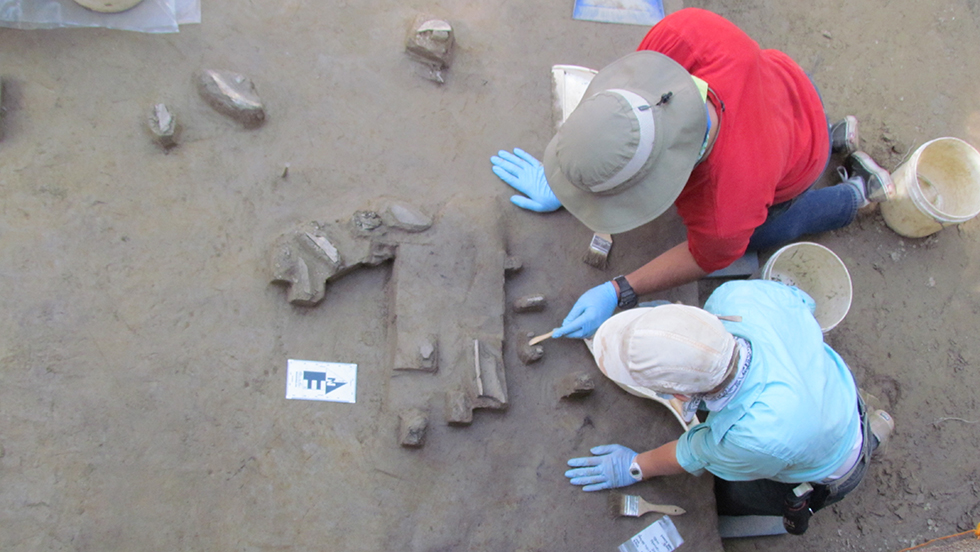
New discoveries connect Indigenous Alaskans to their ancestors
For more than two decades, Professor Brian Wygal, PhD, and Assistant Professor Kathryn Krasinski, PhD, of the Department of Anthropology have conducted collaborative research on past peoples and cultures of Alaska. Their work has resulted in numerous publications and trained more than 100 students from around the world in archaeological field methods. Some of their discoveries have made national and international headlines, including a 2016 discovery of a virtually complete 14,000-year-old woolly mammoth tusk.
Since then, Drs. Krasinski and Wygal have continued to discover and excavate sites across Alaska in the hopes of unearthing artifacts and animal remains that could further expand our understanding of the human past. “We want to know where the First Alaskans came from and what they left behind,” Dr. Wygal said. Their publications on recent findings at the Holzman site—one of the oldest in the Americas, about 70 miles from Fairbanks—prove that even the smallest fragments of evidence can be culturally significant.
Exploring the Last Ice Age
“Archaeological Recovery of Late Pleistocene Hair and Environmental DNA from Interior Alaska” (Environmental Archaeology: The Journal of Human Palaeoecology, January 2022) tracks their recovery and identification of ancient bison hair specimens and environmental DNA from sediments dating back to the end of the last Ice Age, approximately 12,000 years ago.1 When compared to existing data, reconstructions of these specimens can bring to life the hyperlocal environmental transformations that occurred during a time of dramatic climate change.
“Mammoth Ivory Rods in Eastern Beringia: Earliest in North America” (American Antiquity, January 2022) reports on the recovery of two mammoth ivory tools “in the broader context of late Pleistocene bone and ivory technology,” yielding insight into ancient Alaskans’ acquisition and use of mammoth ivory.2
While these findings have been met with tremendous excitement from the scientific community, Drs. Wygal and Krasinski have another audience in mind when digging. “We’re thinking of how Alaska Indigenous communities want to see these projects progress, and the questions they have about their own ancestors. The age of helicopter science is over,” Dr. Wygal said. They have initiated community-based archaeology—an Indigenous-centered approach that is swiftly gaining momentum in the field—to ensure digs are conducted fairly, respectfully and inclusively. “Euro-American colonization has resulted in significant loss of land access for Indigenous peoples across the country,” Dr. Krasinski noted. “Now, instead of taking the lead in archaeological investigations, we are working to support and empower Indigenous communities to care for their heritage as they consider appropriate, like their ancestors did before them.”
Inspiring Adelphi’s Anthopology Students
This philosophy is one Drs. Wygal and Krasinski are careful to impart to their students. “The narratives we’re uncovering with this research are far richer and more complex than what we typically see reflected in popular culture because of collaboration,” Dr. Krasinski said. “I hope students who work with us are gaining appreciation for Indigenous peoples and the importance of preserving these sites for future generations. Ultimately, it’s about creating reciprocal relationships with people and the environment—learning to steward the land rather than exploit it.”
Their discoveries provide many opportunities for student research in Adelphi’s on-campus archaeology lab, which Dr. Wygal describes as a “bustling hub where undergraduates get to do graduate-level work.” Students learn to catalog, photograph and analyze the specimens recovered from the field. Drs. Wygal and Krasinski invite a handful of promising scholars to accompany them on trips to dig sites in Alaska, while some students attend field programs at other institutions.
The research team is currently supervising several independent student projects that build on their findings from the Holzman site. Anthropology major MacKenzie Pina, a junior, is running geochemical analyses on sediment samples to understand Ice Age dietary and cooking habits as well as migration patterns. This summer, Pina will be traveling to Koobi Fora in Africa for her field training. Anthropology major Lillian Barber, a sophomore, is reconstructing and analyzing a set of stone tools, which promises to shed light on ancient toolmakers’ methods. Barber will be an intern at the American Museum of Natural History this summer. And Casey Greenbaum, a fourth-year anthropology student, is analyzing the importance of waterfowl at the Holzman site and will be attending an archaeological field school in Bulgaria this summer. Taken together, their work offers a holistic perspective that Dr. Krasinski believes is key to understanding humanity. “I want students to think about the world in terms of interwoven themes,” she said. “The knowledge and skills we are gaining provides important contexts for living in an interconnected world.”
1 Wygal, Brian T., Krasinski, Kathryn E., et al. “Archaeological Recovery of Late Pleistocene Hair and Environmental DNA from Interior Alaska.” Environmental Archaeology, published online: 31 Jan 2022.
2Wygal, Brian T., Krasinski, Kathryn E., et al. “Mammoth Ivory Rods in Eastern Beringia: Earliest in North America.” American Antiquity, vol. 87, iss. 1, January 2022, pp. 59-79.